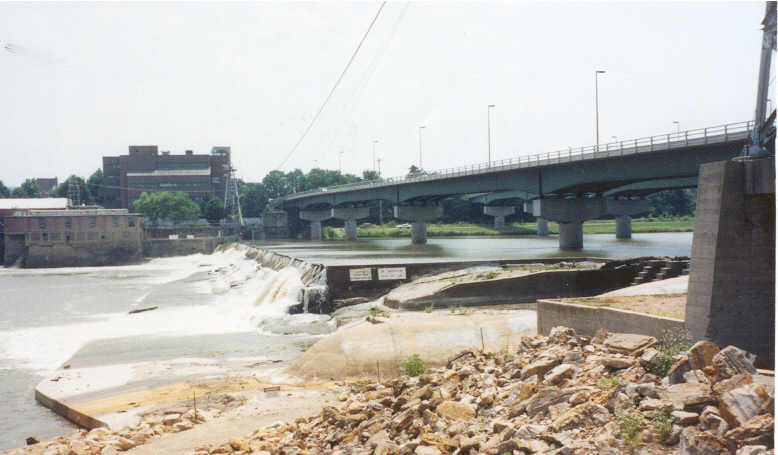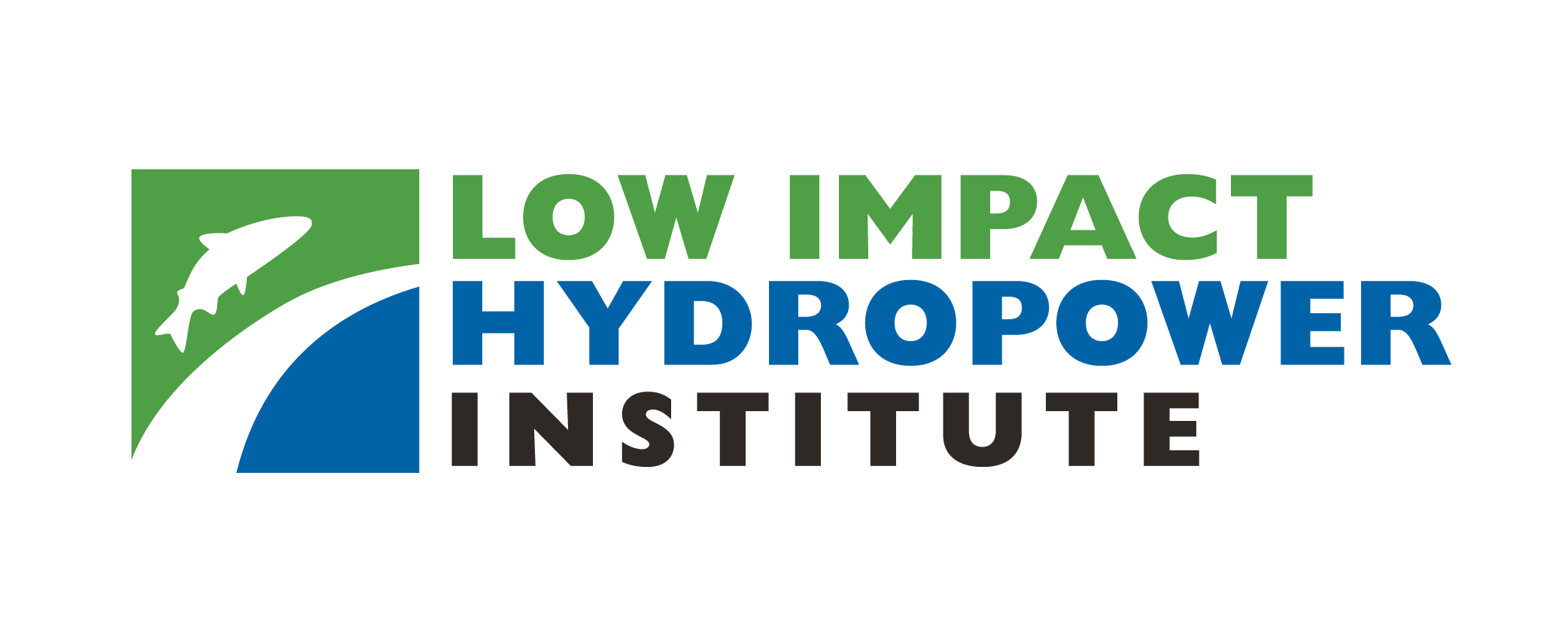LIHI 证书 #15 – 堪萨斯州 Bowersock Mills 项目

| 项目名称 | 鲍尔索克米尔斯 |
| LIHI 证书编号 | 15 |
| LIHI 证书期限 | 2019年7月9日-2029年7月8日 |
| 所有者 | 鲍尔索克磨坊和电力公司 |
| 状态 | 堪萨斯州 |
| 地点 | 位于堪萨斯州道格拉斯县劳伦斯市堪萨斯河 52.4 英里处。 |
| 装机容量 | 总计 7 兆瓦 – 北部 发电站 4.65 兆瓦,南发电站 2.35 兆瓦 |
| 平均年发电量 | 22,277 兆瓦时 |
| 设施类型 | 径流式 |
| 联邦能源管理委员会 不。 | P-13526 于 2010 年签发,有效期至 2060 年 7 月 31 日 |
Bowersock Mills 项目位于堪萨斯州劳伦斯市的堪萨斯河畔。该项目是堪萨斯州唯一获得联邦能源管理委员会 (FERC) 许可的水电项目。Bowersock Mills & Power Company (BMPC) 最初成立于 1874 年,最初是堪萨斯河上的一家磨坊。当时,劳伦斯面临着能源危机,因为一天的马车运输量内的所有木材都已被采伐,导致能源成本大幅上涨。奥兰多·达林在堪萨斯河北岸经营着一家磨坊,并与劳伦斯市合作,同意建造一座 坝 横跨堪萨斯河。达林为维持大坝的稳定而付出了代价,随后试图完成大坝的公司也同样破产。那时,道格拉斯县面粉厂已在堪萨斯河的南侧建立,并在至今仍屹立的 水槽 以及大坝最南端的砌体部分。道格拉斯县面粉厂的运营商JD Bowersock接手了该项目,并成功完成了大坝的建设。Bowersock继续在该地进行面粉加工,并为劳伦斯市提供机械能。面粉厂的运营和机械能生产一直持续到1903年的洪水摧毁了面粉厂的厂房和相关的机械能设备。
Bowersock 建造了一个新的 发电站 (南发电站)于1903年至1905年间建成。南发电站是美国最早的水力发电项目之一,至今仍在发电。北发电站于2012年建成。
Bowersock 大坝从南厂房水槽北侧到北厂房长 655 英尺,高约 17.08 英尺。大坝南侧 1/3 为砌石砌块坝。坝体宽约 8 英尺,坝下游面位于 木制婴儿床 部分采用阶梯式结构,末端为距大坝不同距离的垂直板桩墙。蓄水池或“磨坊池塘”通过五个独立的闸门结构保持稳定水位。南奥伯迈耶段由十五个独立的10英尺奥伯迈耶组成 闪光板 位于大坝南端。大坝中心顶部有四个独立的橡胶囊,每个囊独立运行。第五个控制结构是北奥伯迈耶 门,这是一座位于大坝最北端的20英尺高的闸门。南侧厂房装有七台水轮发电机组,北侧厂房装有四台水轮发电机组,总装机容量为7兆瓦。
该项目运营于 径流 模式,并拦截了423英亩的水库。大坝顶部的自动橡胶囊以及Obermeyer 门 确保蓄水量波动在6英寸以内。流量还由监控和数据采集系统进行监测,该系统可显示水池流量是否显著增加或减少。流量方案是与堪萨斯州卫生与环境部 (KDHE)、美国陆军工程兵团 (USACE) 和美国鱼类及野生动物管理局 (USFWS) 协商后制定的。
项目流域内的水域因总悬浮固体、总磷和大肠杆菌浓度高而被认定为受污染水域。经与KDHE协商后,该机构得出结论,由于该项目的流通性质及其在河流中的长期存在,该项目不会引入导致或加剧这些污染的污染物。
该项目上游的堪萨斯河拥有丰富的鱼类群落,包括古老的非硬骨鱼类(七鳃鳗、鲟鱼、匙吻鲟和雀鳝)、鲱鱼、鲤科鱼类、吸盘鱼、鲶鱼、太阳鱼、大眼鲷和鼓鱼。美洲鳗是项目附近唯一的洄游物种。然而,包括美国鱼类及野生动物管理局和堪萨斯州野生动物、公园和旅游部在内的资源机构并未规定通行措施,因为大坝阻碍了入侵物种亚洲鲤鱼向上游扩散。该河下游的鱼类包括沟鲶、淡水鼓鱼、普通鲤鱼、大口鲈鱼和白鲫鱼。
项目用地面积为664英亩。项目对周边土地的控制力有限,而周边土地正在不断扩张,城市绿地也随之增多。 河岸 土地、耕地等,项目区内不存在具有重要生态价值的土地。
项目附近可能存在的受威胁或濒危物种包括草地马利筋、西部草原流苏兰、淡色鲟鱼、鲟鱼鲢、浅滩鲢、平原鲦鱼、平头鲢、银鲢、镰鳍鲢、西部银鲦鱼、雪鸻、北长耳蝠和东部斑臭鼬。在项目区域内可以观察到多种受《候鸟条约法》和《白头海雕和金雕保护法》保护的鸟类,包括美洲麻鳽、金鸻、白头海雕、黑秧鸡、黑嘴鹃、食米鹬、黄胸滨鹬、黑腹滨鹬、东部三声夜鹰、亨氏麻雀、亨氏塍鹬、肯塔基莺、王秧鸡、最小麻鳽、小黄脚鹬、黄喉地莺、红头啄木鸟、锈色黑鹂、半蹼鹬、短嘴杓鹬和红尾鸫。几十年前,人们曾在该项目下游河段发现淡色鲟鱼,但由于亚洲鲤鱼的存在,资源机构决定不在该区域实施通行规定。美国鱼类及野生动物管理局进一步得出结论,该项目的运营不会对鲟鱼造成不利影响。堪萨斯州针对镰鳍鲢、鲟鱼鲢和西部银鲦制定了一项恢复计划。这些管理活动主要旨在减少对关键栖息地的影响,而这些栖息地正是该项目径流式运营所考虑的。该项目在河流和发电站用地周围设有200英尺(约60米)的缓冲区,以减轻对陆地物种的影响。
项目区域目前没有发现任何文化或历史资源。堪萨斯州历史学会指出,该项目的建设和运营不会影响任何文化或历史资源。
该项目的休闲资源包括步道、独木舟搬运道、垂钓平台和信息亭。免费向公众开放。
合规状态
当前证书中没有针对设施的具体条件
2025: 未发现任何重大变化或合规问题。根据年度审查,该项目仍然合规。
2024: 未发现任何重大变化或合规问题。根据年度审查,该项目仍然合规。
2023: 未发现任何重大变化或合规问题。根据年度审查,该项目仍然合规。
2022: 未发现任何重大变化。该项目报告 橡皮障 2021年发生的故障导致蓄水量突然下降。随后进行的维修导致蓄水量偏离计划。这些偏离情况已妥善报告给联邦能源管理委员会(FERC)和资源机构,并采取了适当的措施,且未对环境造成影响。因此,LIHI认为这并非重大合规问题。
2021: 未报告任何变更或合规问题。根据年度审查,该项目仍然合规。
2020: 当前证书的年度报告尚未生效。
认证历史
2022 年 1 月 1 日: LIHI 证书期限已根据 2022 年 1 月 1 日发布的 LIHI 第 2 版认证手册 2.05 版延长。有关新期限,请参阅上面的设施表。
2020 年 8 月 3 日: 2020年8月1日,申诉期结束后,Bowersock Mills项目重新认证的决定生效,且无人提出申诉。认证期限为2019年7月9日至2024年7月8日。
2020年7月2日: 低影响水电研究所 (LIHI) 已初步批准 Bowersock Mills 项目获得为期 5 年的新一期低影响认证。此决定尚待 30 天的申诉期过后才能做出。只有在 60 天的评论期内对初始申请发表意见的人员才有资格提出申诉。此类申诉需要说明该项目为何不符合 LIHI 标准。申诉请求可以通过电子邮件发送至 comments@lowimpacthydro.org 请在邮件主题中注明“Bowersock Mills 项目”,或邮寄至低影响水电研究所,地址:329 Massachusetts Ave, Suite 6, Lexington, MA 02420。所有申请都将发布在网站上。申请人将有机会回复,回复也将发布。 申请必须在 2020 年 8 月 1 日美国东部时间下午 5 点之前收到完整的申请和审核报告如下。如果没有收到申诉请求且该决定成为最终决定,则该项目的认证期限为2019年7月9日至2024年7月8日。
2020年4月27日: 低影响水电研究所 (LIHI) 已收到 Bowersock Mills 水电项目低影响重新认证的完整申请。完整申请可在下方找到。LIHI 正在就此申请征询公众意见。意见需与 LIHI 的具体标准(流量、水质、 鱼道等)将非常有帮助,但所有评论都会被考虑。评论可以通过电子邮件提交给研究所 comments@lowimpacthydro.org 请在主题行中注明“Bowersock Mills 项目评论”,或邮寄至低影响水电研究所,地址:329 Massachusetts Avenue, Suite 6, Lexington, MA 02420。 评论必须在 2020 年 6 月 26 日东部时间下午 5 点或之前收到 予以考虑。所有评论都将发布到网站上,申请人将有机会作出回应。任何回应也将发布。
2015年9月25日: LIHI 执行董事 Michael J. Sale 凭借 LIHI 管理委员会授予的权力,认定 Bowersock 水电项目(FERC 编号 13526)继续符合 LIHI 认证标准。Bowersock 项目的认证生效日期为 2014 年 7 月 9 日,有效期为五 (5) 年,将于 2019 年 7 月 9 日到期,但需满足以下条件:
- 2020年很满意。 条件 1. 设施所有者应向 LIHI 提供一份关于设施当前休闲娱乐计划现状和进展的简要报告。该总结报告应作为下一份年度合规报告的一部分提交给 LIHI。如果届时休闲娱乐计划的进展被认为令人满意,则此条件将被取消。
2015年4月20日: 2015年4月16日,LIHI收到了鲍尔索克米尔斯电力公司(BMPC)提交的鲍尔索克米尔斯水力发电设施延长认证期限的完整申请。由于设施发生重大变更,且BMPC需要更多时间收集文件和支持材料,申请材料被延误。2014年的申请如下。
2010年1月27日: 经长岛能源公司(LIHI)管理委员会确认,鲍尔斯克项目继续符合认证标准。该项目已获得重新认证,认证有效期为五年,自2009年7月9日起生效,至2014年7月9日到期。
2004年10月: Bowersock Mills 项目已被认证为低影响项目,有效期为五年,自 2004 年 7 月 27 日起生效,至 2009 年 7 月 27 日止。
认证文件
2020 年重新认证
2015 年重新认证
- Bowersock Mills 2015年重新认证审查报告
- Bowersock Mills 2014年再认证问卷
- 申请附件 – 2014 年说明和联系方式
- 申请附件 – 机构意见
- 申请附件——受威胁和濒危物种
- 申请附件——运营监控计划
